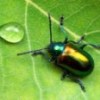
Heterospilus, undescribed species, Costa Rica
My more astute readers may have noticed that Myrmecos Blog has been uncharacteristically quiet this week. I do apologize, but I have a regular research job aside from blogging that periodically requires attention.
I've been assembling genetic and morphological data from 100 or so wasps in the hyperdiverse genus Heterospilus. These are small insects, typically under a centimenter in length, that attack stem-boring grubs like beetle and moth larvae. This week I am patching up the holes in the molecular data matrix, and this requires bench time and sequence editing time.
Why are we interested in these wasps?
Well, Heterospilus is a big part of the "Taxonomic Impediment" in the Neotropics. They are among the most common wasps collected in biodiversity surveys, yet in our study sites in Costa Rica not a single one of the 400+ species has been described by taxonomists. It is hard to compare data among sites or monitor the decline of biodiversity without a stable taxonomy.
As part of the project we're trying to make sense of the bewildering array of colors, shapes, and sizes by mapping them to a phylogeny (that is, a genealogy of how the species are related). If we can discover the patterns of how traits evolve we'll both improve our basically non-existent understanding of the wasps and be more able to craft a taxonomy structured around evolutionary lineages.
Our preliminary results indicate that the color of the wasps' antennae evolve extraordinarily slowly. Much more slowly than traits like ovipositor length that are directly related to parasitic behavior, and more slowly even than the number of antennal segments themselves. Considering that color is a trait most entomologists consider highly labile (color variants within species are common- as in peppered moths), we were surprised and we're hoping to pick up some clues- from a pile of preserved museum specimens- why this might be so.
Anyway. Back to work.


And what does your research suggest concerning the evolution of the stigma-like swelling in the hind wings of male Heterospilus?
I wish I knew. That's a key synapomorphy of the cluster of genera to which Heterospilus belongs- it might serve a flight stabilization function, but I don't think anyone has studied it. As the hind wing stigma is present in the males of all the species in our study, it's not something we'll be able to correlate with other character states.
But it is hard to see a need for flight stabilization pertaining only to males. Has anyone studied the mating behavior of Heterospilus or related genera?
Bob Carlson is on the right track, i think.
Never underestimate the power of a fickle female LOL.
Among all science that is being done today, documenting biodiversity may be the most important. One good species description in a proper taxonomic monograph is worth a thousand blog posts (although the entertainment value almost always is higher in the latter)
Glad to see your post back. I was going into withdrawal!
Interesting to see a white band on the antennae of a braconid. In puttering around trying to understand my garden biodiversity, I had great hopes for identifying an ichneumonid with a similar band (on much shorter antennae). Unfortunately, the local ichneumonid student tells me there are lots of her wasps with white bands on the antennae. If there is a lot of convergence, then presumably a function is a reasonable hypothesis - but what good is a white band?